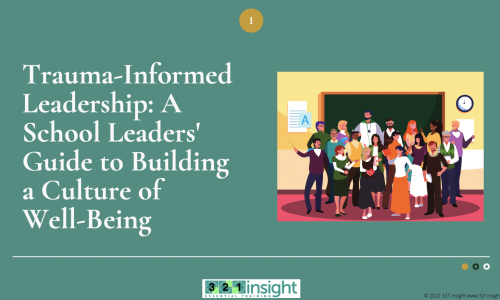At 321 Insight, we help K-12 staff meet growing student needs by providing bite-sized, relevant, and engaging job-specific PD. Get a free trial of one of our solutions to see what 321 Insight can do for your school or district!
Introduction
Paraeducators are essential members of our classrooms. They are often tasked with working directly with students who have experienced adverse childhood experiences. Yet, despite their frontline role, paraeducators frequently receive little or no formal training on how trauma impacts student behavior, learning, and relationships.
This training gap leaves paraeducators unprepared to recognize trauma responses, adapt their approach, or support students effectively. With school populations experiencing rising rates of adverse childhood experiences (ACEs), equipping paraeducators with trauma-informed training is no longer optional — it’s essential.
Research shows that trauma-informed training enhances paraeducators’ confidence, improves classroom climate, and reduces discipline incidents and burnout (Purtle, 2018). This post explores why trauma-informed training for paraeducators matters, what the research says, and how schools can provide meaningful, lasting training that benefits both staff and students.
Summary
- What is Trauma-Informed Training — and Why Paraeducators Need It
- At its core, trauma-informed care (TIC) is a framework that recognizes how trauma shapes student behavior, learning, and relationships, and uses that understanding to guide how adults respond.
- What the Research Shows: Why Training Paraeducators Works
According to the National Child Traumatic Stress Network (NCTSN), over two-thirds of children report experiencing at least one traumatic event by age 16. In high-poverty districts, that number is even higher. But trauma isn’t just about one (or more) traumatic events, Chronic daily stress of living in adverse conditions compounds on students, impacting their ability to regulate their emotions and behavior. Paraeducators, who often work in special education and behavioral intervention roles, are especially likely to encounter students with significant trauma histories.
- What Effective Trauma-Informed Training Looks Like for Paraeducators
Based on best practices outlined by Berger & Quiros (2016), effective training for paraeducators should include:
- Basic trauma education (types, impacts, and signs of trauma).
- Practical strategies for trauma-sensitive communication.
- Real-world case studies from classroom settings.
- Hands-on practice through role-playing scenarios.
- Self-care and boundary-setting skills to help educators recover and be more resilient to stress.
- Real-World Example: Core Curriculum on Childhood Trauma
To ensure consistent, high-quality trauma-informed training across school roles, the Core Curriculum on Childhood Trauma was developed by the National Child Traumatic Stress Network.
- Addressing Barriers to Training Paraeducators
- Common Challenges
- Time and Funding — Paraeducators often receive less professional development than teachers and have less contracted time for training opportunities.
- High Turnover — Frequent staff changes dilute training impact.
- Lack of Respect — Paraeducators may feel overlooked in school improvement efforts.
What is Trauma-Informed Training — and Why Paraeducators Need It
Defining Trauma-Informed Care (TIC) in Schools
At its core, trauma-informed care (TIC) is a framework that recognizes how trauma shapes student behavior, learning, and relationships, and uses that understanding to guide how adults respond. In the classroom, TIC means creating an environment of:
- Safety — Students feel physically, emotionally, and psychologically safe.
- Trustworthiness — Adults are consistent, predictable, and clear.
- Collaboration — Students and adults share power and responsibility where possible.
- Empowerment — Student voice is honored, and students build skills for self-advocacy.
- Cultural and Historical Sensitivity — Adults acknowledge and respect students’ lived experiences.
The Role of Paraeducators
Paraeducators spend more one-on-one time with students than many classroom teachers. They assist with behavior management, academic support, and personal care, often working closely with students experiencing trauma or behavioral challenges.
Without trauma-informed training, paraeducators may:
- Misinterpret trauma-driven behaviors as defiance or manipulation.
- Use punitive responses that escalate distress.
- Feel personally triggered by student aggression or emotional outbursts.
- Experience burnout and compassion fatigue due to a lack of tools and support.
- Lower expectations for the student
Myths about Trauma-Informed Practices
When educators hear about trauma-informed practices they often misunderstand what this means. We want to be clear about what TIC is but also what it is not. Being trauma informed DOES NOT MEAN:
- You are identifying who has trauma and treating them differently than other children.
- You are lowering expectations for children or making excuses for their behavior.
- The educator doing therapy or talking about trauma directly.
What the Research Shows: Why Training Paraeducators Works
Trauma is Common Among Students
According to the National Child Traumatic Stress Network (NCTSN), over two-thirds of children report experiencing at least one traumatic event by age 16. In high-poverty districts, that number is even higher. But trauma isn’t just about one (or more) traumatic events, Chronic daily stress of living in adverse conditions compounds on students, impacting their ability to regulate their emotions and behavior. Paraeducators, who often work in special education and behavioral intervention roles, are especially likely to encounter students with significant trauma histories.
Trauma-Informed Training Improves Staff Confidence and Student Outcomes
In a systematic review of trauma-informed organizational change, Purtle (2018) found that training staff at all levels — including paraeducators — led to:
- Increased trauma awareness and confidence.
- Better staff-student relationships.
- Fewer disciplinary referrals and classroom disruptions.
- Improved emotional support within school teams.
Case Study: Trauma Training Reduces Teacher and Paraeducator Burnout
A 2020 study by Berger et al. explored the impact of trauma-informed training combined with social-emotional learning (SEL) for school staff — including paraeducators. Findings showed:
- Paraeducators reported feeling more equipped to handle trauma-triggered behavior.
- Classrooms experienced fewer behavior incidents and increased student engagement.
- Paraeducators felt more valued and supported by school leaders.
(Berger et al., 2020)
Trauma Training Increases Cultural Competency
Trauma-informed training also helps paraeducators understand the intersection of trauma and culture. Research highlights that students of color, LGBTQ+ students, and students with disabilities experience higher rates of trauma (Substance Abuse and Mental Health Services Administration, 2014). Training helps paraeducators:
- Recognize racial and cultural trauma.
- Use culturally responsive de-escalation techniques.
Avoid unintended biases in interpreting student behavior.
What Effective Trauma-Informed Training Looks Like for Paraeducators
Core Elements of Training
Based on best practices outlined by Berger & Quiros (2016), effective training for paraeducators should include:
- Basic trauma education (types, impacts, and signs of trauma).
- Practical strategies for trauma-sensitive communication.
- Real-world case studies from classroom settings.
- Hands-on practice through role-playing scenarios.
- Self-care and boundary-setting skills to help educators recover and be more resilient to stress.
Training Should Be Ongoing
One-time workshops are insufficient. Research consistently shows that ongoing professional development, paired with coaching and reflection, has the greatest impact on classroom practice (Purtle, 2018). This means:
- Monthly check-ins to revisit trauma-informed strategies.
- Opportunities for paraeducators to share challenges and solutions.
- Supervisors modeling trauma-informed communication in staff interactions.
Building Trauma-Informed School Culture
Training works best when paired with whole-school commitment to trauma-informed care. According to the National Child Traumatic Stress Network (NCTSN), this includes:
- Leadership support for trauma-informed practices.
- Integrating TIC into discipline policies.
- Creating calm-down spaces for students.
- Embedding trauma-informed language into IEPs and behavior plans.
Real-World Example: Core Curriculum on Childhood Trauma
To ensure consistent, high-quality trauma-informed training across school roles, the Core Curriculum on Childhood Trauma was developed by the National Child Traumatic Stress Network. This evidence-based curriculum is used to train:
- Teachers
- School counselors
- Paraeducators
- Administrators
Key benefits include:
- Ensuring all staff use common language and approaches.
- Direct connection to current brain science and trauma research.
- Emphasis on practical strategies — not just theory.
(NCTSN Core Curriculum)
Addressing Barriers to Training Paraeducators
Common Challenges
- Time and Funding — Paraeducators often receive less professional development than teachers and have less contracted time for training opportunities.
- High Turnover — Frequent staff changes dilute training impact.
- Lack of Respect — Paraeducators may feel overlooked in school improvement efforts.
Solutions
- Build trauma-informed training into onboarding and annual PD.
- Offer stipends or CEUs for completing trauma training.
- Designate “trauma champions” to mentor new paraeducators.
Include paraeducators in trauma leadership teams to elevate their voice.
Conclusion: Trauma-Informed Training Empowers Paraeducators
When paraeducators receive comprehensive trauma-informed training, the benefits ripple across the classroom. Students feel safer and more supported. Teachers experience fewer disruptions and stronger classroom communities. Paraeducators themselves feel more confident, respected, and prepared for their critical role.
As research from Purtle (2018), Berger et al. (2020), and NCTSN consistently shows, investing in trauma-informed training for paraeducators is one of the most effective ways to build compassionate, effective classrooms.
Ready to equip your paraeducators with the tools they need? Explore 321 Insight for flexible, expert-designed training tailored for school staff.
Free Ebook
Trauma-Informed Leadership: A School Leader’s Guide To Building A Culture Of Well-Being
This hands-on guide provides leaders with proven strategies that can be immediately implemented to help staff and students overcome today’s challenges. Use this guide to review your current district or school environment, assess staff needs, and develop a viable plan for building a school or district-wide culture of well-being.

Free Webinar
We are seeing a massive spike in behavior, anxiety, depression as people try to navigate the expectations of returning to school. The impacts of the past 18+ months of a global pandemic, stressful societal conditions, increased reliance on technology and screens, and the loss of routines has resulted in stress and dysregulation amongst staff and students alike. Successfully navigating this requires a deliberate plan. District and school leaders need to understand why it’s happening and what to do about it.




